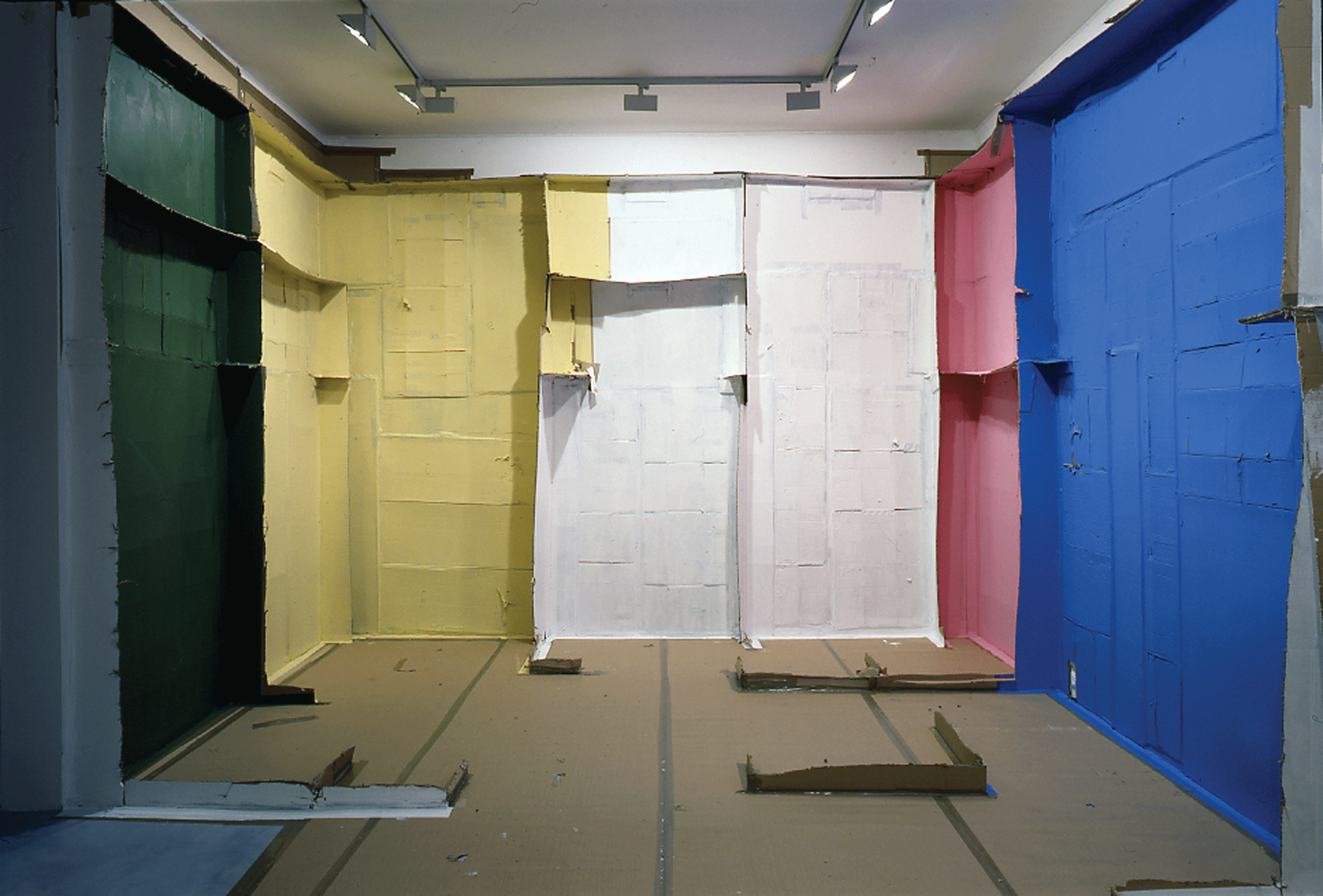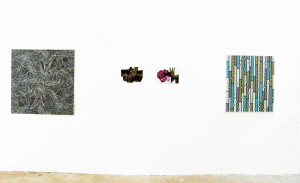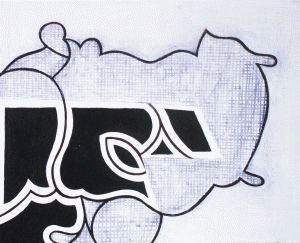« Features
PEINTURE PRESQUE ABSTRAITE
By Claude Temin-Vergez
Painting’s omnipresence today is difficult to untangle from the climate of insecurity and safe value strategies associated with its format. Although it might seem fair to a medium that had been precipitated into darkness in past decades by the advent of conceptualism, the installation generation and the tidal wave of new media, its eclipse was not always unfounded. What interests me here is the effect of those decades on a genre that was born from the modernist project and seems to have carried through with constant conceptual adjustment. The abstract problem, in which my own practice is rooted, is here in question.
Three years ago, I was invited to take part in “The Expanded Painting Show.” Its basic concept relied on an analogy with R. Krauss’ “Sculpture in the Expanded Field,” but applied to painting in a new positive outlook and in the light of a postmodern, highly media-driven society. As a matter of fact, I am writing this on my iPhone, with my Mp3 gear on, fully connected and digitalized.
This concept, however, is not new. Movements, like Support-surface or BMPT in France as well as Minimalism in America in the 1970s, already envisaged the possibility of considering painting in a wider scope; whether unfolding its constructs, exploring its relationship with architecture, sculpture, film and the environment. What has happened since is a sheer explosion of new media in the world and in art practices. How does the medium of painting respond to this?
Present in these shows, New York-based Tim White-Sobieski’s ambitious plasma screen installation literally allowed you to see the paintings folding and unfolding into endless combinations. Although conforming to formal modernists’ means of painting, geometry, color combinations and systems, the digital movement and rendering on the screen created a highly hypnotic experience.
Dominic Lejman’s projection onto canvas, also a literal application of technology into the process of painting, proposed a film of a corpse in one of the classic reclining postures of Christ. The display of a moving (but still) image on the “symbolic” canvas medium provoked a gut reaction by allowing you to stare at iconographic video-stillness. Carlos Bunga’s ephemeral and architectural experiments were more reminiscent of the low-key spirit of Support-surface. His work provided poignant insight into the concept of painting’s expansion by stripping away the possibilities of means of painting and exploring its relationship between structure and environment.

Carlos Bunga, Elba Benítez Project, 2005, Cardboard, adhesive tape, matt paint, light table and slides, Photo: Luis Asín.
“La Peinture est Presque Abstraite” (1) (Almost Abstract Painting) is another project in which I have recently been involved. Although focused in part on the influence of new media on painting, it is quite different in its scope.
Some of the artists in the show might be working with digital media and video (Xavier Drong) or installation (Nicolas Royer and I), but the particular works selected for the exhibition seemed deeply rooted in painting’s tradition. Canvas or board on stretchers is used, always hung frontally and more or less square; in short, a painting show.
Even if the works in question clearly emerged from the abstraction genre, they made use of all things representational: images, figures, icons, ornaments, screens and signs, with a kind of distance that they all share. Far from mere repetition, they loop, clone and use aliases … Clarity and attention to surface are recurrent themes in the work as well as a kind of “digested” mixing of codes and signs fed by contemporary experience and technology. These works equally enjoy playing with graphic and pictorial codes of art and painting tradition, as well as those of our contemporary environment (2).
The “Abstract ” Problem
In today’s post-medium age, the position of abstract painting is problematic. The common notion that it could not progress beyond the monochrome is now a given and echoed in what (Blois 229) perceived as the impasse of Modernism itself. The post-modern and conceptual era left but little space for painting, which was in a sense happy to thrive out of the limelight.
Today the conceptual model itself is being reassessed in light of the Fluxus movement and hippy culture, as a set of propositions, which had its time. Indeed critic Jan Verwoert titled his recent series of lectures: “Why are conceptual artists painting again? Because they think it’s a good idea.”(3)
Emerging from this bumpy road, painting evolved from Modernism to a dead-end to a rebirth of sorts. It bears the stigma of these traditions from Modernism to Post-Modernism, Minimalism and Conceptualism.
Survey exhibitions examining the position of painting often reactivate the traditional dichotomy abstraction-figuration. This dichotomy only serves to stigmatize the question of the “tableau” within the heterogeneity of two painting traditions, one coming from Picabia and the other from Mondrian. Another view is proposed here: painting as a mixing up of the codes between media and art.(4)
Painting is often envisaged “after photography” (as in the recent Hayward Gallery show in London, “The Painting of Modern Life”), but this project proposes a wider and richer relationship with other new media and technologies (whether computers, the Internet, billboards, graphic design, advertisements, urban signs and culture …) and shows painting able to thrive as a vehicle for the expression of contemporary experience in a media-driven world at ease with popular culture.
In the show “As Painting,” a large survey exhibition set at the Wexner Center for the Arts in the United States in 2001, Stephen Melville, drawing from the Support-surface group, proposed a reading of abstract painting as intrinsically divided; the medium being folded, collaged or woven as to include other media, and therefore displacing “painting” per se. The nature of present attitudes seems radically opposed to such an approach. They envision painting positively embracing the new media culture, and able to retain its identity, coming out enriched by this dialogue rather than displaced by it.
Authentics, Hypers, Systematics, and Eclectics
A couple of years ago, I read a catalogue essay by Matthew Collings of a huge survey exhibition of painting at Flowers East Gallery in London. In his unique, sometimes rather un-reverential and always funny way, he was trying to categorize the work of these 70 abstract painters from different generations; needless to say, a tedious task for a medium that has always resisted definition, let alone classification. His sense of humor probably helped him tackle such an endeavor. His categories were: the Authentics, the Hypers, the Systematics, and the Eclectics (Collings 4).
The Authentics were painters from an older generation who basically use improvisation at the base of their work and are respectful of European & American post-war art in a kind of genuine way. They try and create works that still fit this tradition, but in a contemporary, utterly different context. The Systematics were artists who use rigor and a set of rules to go about making their work with a conceptual drive. They rely on integrity, setting something up - it must be the right thing- and following it through.
Then you had the Eclectics who seemed to use processes that belonged to all the other categories and they made up the biggest part of the show. They seem to have a strong sense of geometry and a kind of systematic approach, but also respect a certain atmospheric feel, dear to the Authentics.
After that you had the category of the Hypers, defined by Collings as a younger generation of artists. I will quote him directly here:
“Probably some of them went to art schools where the Authentics taught in the 80s. But they reject the Authentics’ idea of authenticity and want to express something about a world that doesn’t care about it either. They do a kind of hyper-abstraction where you can believe there is a faint respect for the same painting traditions the Authentics like, somewhere in the picture, but a world of doubt too. They don’t take it for granted that rough, open, atmospheric feel is sincere. It could just as well be fake - since it’s so much part of nostalgia. Or fake might be good. Their style has an ironic look. If there are brush strokes visible at all, they seem as if they’re fetishized rather than real “(Collings 4).
Matthew Collings would probably agree that most of the works featured in “La Peinture est Presque Abstraite” fit into the hyper category. So this is, of course, much of a caricature, but helps perhaps to define the territory on which this project was built.
For David Ryan, Olivier Gourvil’s Erostar (2007) is a bold diagrammatic exposition in black and yellow of a sexualized body - a body of overlapping folds of flesh, a grotesque hybrid of hanging udders and protuberant lumps … The work anthropomorphism is filtered through an immense repertoire of sign-structures, some sifted through urban signs or the signs of the body as seen in comics or graphics. In some of his paintings, forms can have the look of architectural plans, pre-fabricated design units, bulbous forms of graffiti or elements from modernist painting (Ryan 31).
Impurity and Extremes
What seems to connect the works is the shared impurity of their sources as a kind of reaction against the constant quest for purity led by their modernist predecessors. This denotes a moving away from theoretical frameworks provided by Clement Greenberg and Michael Fried.

“La Peinture Est Presque Abstraite” Installation view from left to right C. Temin-Vergez, Meta-drawing#2, 2008; X. Drong, BS_03, 2008; R. Kirwan, Perfect Conditions, 2009.
Cited as one of the most quietly influential painters for almost two decades,(5) Thomas Nozkowski’s work embodies the modernist abstraction tradition, while transporting us to cuckoo land by means of a highly considered staging of infectious references ranging from contemporary architecture, nature to details of Durer’s 1501 detailed ornaments. Jonathan Lasker is another enormous influence on today’s younger generation abstractionists. He fascinates through his ability to give theatrical presence to his “abstract events.” Mary Heilmann, an equally important figure, manages to reconcile abstract references and everyday life.
Current positions seem to exacerbate opposite extremes: expressionism and the deadpan, Rococo and minimalism, graphic design and gestural abstraction, formalism and improvisation, excess and restraint. These are many of the dichotomies at the root of this venture.
Richard Kirwan’s work (on the far right in Figure 4) excels at playing opposites. For David Ryan, Kirwan’s work prefers to dispense with relational composition. His pieces are made up of disjunctive fields, divided or repetitive accumulations that tend to approximate diagrams of cellular structures or microscopic units. But they also clearly celebrate a rampant Pop culture, as in False Fire (2009) with its “Ghostbusters” or computer-game personages. In Foreign Tongue (2009), a backdrop of brightly colored bands provides the foil to a repetitive cluster of silvery forms, which resemble a stack, a pile or a dump (Ryan 35).
All the artists present here share a strong sense of a centered organization of space and a preoccupation with the image on the surface, rather than a concern for objecthood. They also share a strong conceptual stance on decision making and an idea of construction of the “tableau.”
Namely: “… a key modernist question: ‘the rejection of composition’ as a rationale for making decisions. What is at stake here is the critical conviction that consistent decisions in painting should transcend mere tasteful composition. The rational grid and spontaneous gesture were formal means introduced to undermine a rationale of decision making based on compositional consideration” (Verwoert 54).
Current relevant strategies in painting seem to embrace modern tradition by keeping it in check, while browsing the vast vocabulary of our contemporary visual experience. Long gone is the myth of the lonesome improvising genius. These stances allow the work to stand with a strong sense of clarity, while distilling impure sources through a kind of filter that renders them devoid of sentimental charge.
NOTES
1. This project arose after two French artists, Olivier Gourvil and Geoffroy Gross, were offered carte blanche at the Transpalette Art Centre in Bourges, France in May 2008. They proposed to curate a painting exhibition (”La peinture Est Presque Abstraite” May 2009) bringing 4 French (Xavier Drong, Nicolas Royer, Geoffroy Gross and Olivier Gourvil) and 4 British artists (Jane Harris, Richard Kirwan, Daniel Sturgis and Claude Temin-Vergez) together. The book La Peinture Est Presque Abstraite published at Analogues Editions was launched at the Institut Francais in London in November 2009 where the show toured.
2. See Gourvil, Olivier & Geoffroy Gross. Oxymore and more, a proposal, 2008.
3. See Verwoert, Jan. “Why are conceptual artists painting again?” Conference at unitednationsplaza in Berlin on October3, 2008.
4. See Gourvil.
5. See Schwabsky, Barry. Thomas Nozkowski. Haunch of Venison, 2004.
WORKS CITED
Blois, Y. A. Painting as model. MIT Press, 1993.
Collings, Matthew. Rough Guide to playful thoughts on abstract art. Catalogue of the exhibition British Abstract Painting, 2001.
Ryan, David. “Almost…but not quite…” La Peinture Est Presque Abstraite. Analogues Editions, 2009.
Verwoert, Jan. “Choosing to choose.” Parkett. no. 84, 2008.
Claude Temin-Vergez is a French painter and Senior Lecturer at Camberwell College of Arts, who studied painting at Central St. Martins College of Arts, Royal Academy Schools. Temin-Vergez recently contributed to the book and exhibition “La Peinture est Presque Abstraite” (2009) which toured France and the United Kingdom.




































